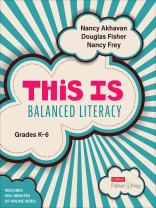This is Balanced Literacy: Grades K-6
Students learn to read and write best when their teachers balance literacy instruction. But how do you strike the right balance of skills and knowledge, reading and writing, small and whole group instruction, and direct and dialogic instruction, so that all students can learn to their maximum potential?
The answer lies in the intentional design of learning activities, purposeful selection of instructional materials, evidence-based teaching methods, and in strategic groupings of students based on assessment data. Together, these create the perfect balance of high impact learning experiences that engage and excite learners. In this hands-on essential guide, best-selling authors Douglas Fisher, Nancy Frey, and Nancy Akhavan help you define that balance for your students, lighting the path to implementing balanced literacy in your classroom. Their plan empowers you to integrate evidence-based approaches that include:
• Instructional materials comprised of both informational and narrative texts.
• The best uses of instructional delivery modes, including direct and dialogic instruction.
• Grouping patterns that work best to accomplish learning aims for different learners at different stages.
• Instruction in foundational skills and meaning making, including oral language, phonemic awareness, phonics, fluency,
vocabulary, comprehension, and writing.
• Technology used as a tool for increasing learning of a specific literary process.
All the tips and tools you need to realize the goal of balanced literacy learning are included, with classroom videos that show strategies in action. Tap your intuition, collaborate with your peers, and put the research-based strategies embedded in this roadmap to work in your classroom to implement or deepen a strong, successful balanced literacy program. Grow as a reading and writing teacher while leading your students to grow as readers and writers.
Daftar Isi
Chapter 1 – Defining Balance, Finding Balance
Chapter 2 – Whole Class Reading Instruction: High-Level Support for Learning
Chapter 3 – Whole Class Writing Instruction: High-Level Support for Learning
Chapter 4 – Collaborative Reading and Writing: Learning in the Company of Peers
Chapter 5 – Small Group Reading Instruction: Targeted Support Through Guided Learning
Chapter 6 – Small Group Writing Instruction: Targeted Support Through Guided Learning
Chapter 7 – Independent Reading: Practicing, Applying, and Extending Learning
Chapter 8 – Independent Writing Instruction: Practicing, Applying, and Extending Learning
Chapter 9 – Assessment and Intervention in the Balanced Literacy Classroom: Noticing and Responding to Students′ Needs
References
Tentang Penulis
Dr. Nancy Akhavan has spent more than 30 years as an educator and consultant. Her work focuses on student support through literacy instruction and intervention, English Language Development, leadership development and organizational systems to increase student achievement. Currently, she is an Associate Professor in the Department of Educational Leadership at Fresno State. She is the founder of Nancy Akhavan Consulting, Inc. Dr. Akhavan has been a bilingual teacher, principal of three schools, and a district administrator of a large urban district for ELA, Math, Social Studies, Science and World Languages. She also served as Assistant Superintendent Secondary Division in a large urban school district. Dr. Akhavan is recognized for her expertise in teaching literacy practices and has published twelve books that focus on instruction that increases student achievement, and has worked with districts and county offices in multiple states and internationally to increase student achievement in reading, writing, and in content areas.












